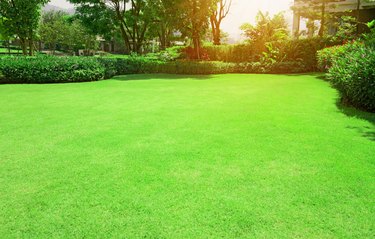
The key to growing grass in hot weather is to select and plant the correct type of grass for your region. Generally, the world of grass is divided into two hemispheres: warm-season grasses and cool-season grasses. Those living in the southern half of the country will generally do best opting for warm-season grasses. Growing these grasses in hot weather is not a problem, as hot weather is when they grow best.
Meet the Warm-Season Grasses
Video of the Day
When grass professionals advise a homeowner about what type of grass to plant, they look at the United States as two separate grass-growing regions. One area is warm and often humid, the other cool. Anyone living in the southern states, where the weather gets hottest, generally does best with warm-season lawn grasses. These grasses grow best in hot weather, while cool-weather grasses can go dormant in summer.
Video of the Day
But the phrase "warm-season grass" is not the be-all and end-all. There are many different types of warm-season grass, including Bermudagrass, Bahiagrass, Centipede grass, and Zoysia grass. Selecting among them is beyond a question of climate, as other factors must be taken into account, including personal maintenance choices and regional differences that affect lawn health. These include the level of heat, the humidity, and the acidity of the soil.
Select a Warm-Season Grass
How hot will your summers get, and how humid? That's an important question when it comes to selecting a warm-season grass. Most popular warm-season lawn grasses in this country hail from tropical and subtropical regions around the globe, so they stay green and keep growing during high-temperature weather.
Most — with the exception of Centipede grass — also have a high tolerance for drought and a moderate tolerance for cold weather. Bahiagrass is the best choice for areas with high humidity. Matching your grass to soil conditions helps reduce labor and the need for added fertilizers and amendments.
Acidity of soil also matters, and by selecting your grass with soil conditions in mind, you'll have less work to do. If your soil is acidic (low pH), almost any of the warm-season grasses will thrive. But homeowners with alkaline soil shouldn't consider Centipede grass or Bahiagrass, since they will likely develop iron deficiency. Either Bermudagrass or Zoysia grass is more tolerant of a range in pH.
Then consider the time you wish to spend maintaining your new lawn. Though every lawn grass must be mowed and fertilized, some demand more work than others. Bermudagrass is the speediest of the warm-season lawn grasses, creating a tough, durable lawn — if you don't mind mowing twice a week and feeding every month during the summer. Centipede grass is the slowest-growing warm-season grass and needs little fertilizer, but is less tolerant of drought. Zoysia grass is moderate in mowing and fertilizer requirements, but dethatching will be needed if you apply fertilizer.
Plant a Warm-Season Grass
The best time to plant warm-season grass seeds is in early spring, starting in about April. The idea is to get the seeds going while the weather is still mild. Grass has a very difficult time germinating in the broiling temperatures of summer. Spring is ideal since the weather is warm but not hot, and hot summer weather — meaning the most vigorous growth for warm-season grasses — is just around the corner.